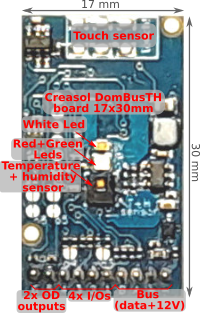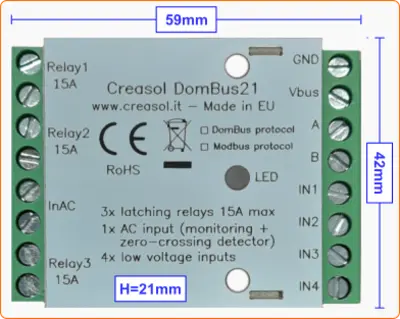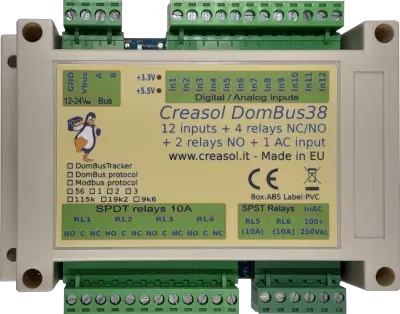

Email: store@creasol.it - Telegram: CreasolTech - Whatsapp: +393283730010
Correo prioritario: rápido y económico - Mensajería ur
¡Contáctenos antes de devolver productos!

Creasol DomBus23 es un módulopara sistema domóticocon varios tipos diferentes de entradas / salidasen un tamaño corto: 74x72x24mm. p>
Se puede conectar al controlador Domoticz mediante un bus serie RS485 (4 cables, 2 para fuente de alimentación de 12/24 V y 2 para datos a 115200 bps).
Como otros dispositivos DomBus,DomBus23 está diseñado para consumir poca energía, ser confiable, totalmente configurable y fácil de usar.
 Soporte completo: ¡la mayoría de los productos están diseñados por nosotros!
Soporte completo: ¡la mayoría de los productos están diseñados por nosotros!
Email: store@creasol.it - Telegram: CreasolTech - Whatsapp: +393283730010
 Los pedidos se envían en 1 día laborable
Los pedidos se envían en 1 día laborable
Correo prioritario: rápido y económico - Mensajería ur
 24 meses de garantía, fácil devolución/reembolso
24 meses de garantía, fácil devolución/reembolso
¡Contáctenos antes de devolver productos!
Creasol DomBus23 es un módulopara sistema domóticocon varios tipos diferentes de entradas / salidasen un tamaño corto: 74x72x24mm. p>
Se puede conectar al controlador de automatización del hogar mediante un bus serie RS485 (4 cables, 2 para fuente de alimentación de 12/24 V y 2 para datos a 115200 bps).
Los controladores de sistemas de automatización del hogar compatibles sonDomoticz.
Como otros dispositivos DomBus,DomBus23 está diseñado para consumir poca energía, ser confiable, totalmente configurable y fácil de usar.

p>
fuerte>
Más información en https://www.creasol.it/CreasolDomBus23
Dirección predeterminada: 0xff23
| Puerto# | Nombre | Capacidades | Configuración predeterminada | Descripción |
| 1 | RL1 | OUT_DIGITAL, OUT_RELAY_LP, OUT_BLIND | OUT_RELAY_LP | Salida de relé SPST, con velocidad de contacto 250Vac 5A o velocidad de contacto 30Vdc 5A. El contacto del relé está protegido contra sobretensiones por varistor |
| 2 | RL2 | OUT_DIGITAL, OUT_RELAY_LP, OUT_BLIND | OUT_RELAY_LP | Salida de relé SPST, con velocidad de contacto 250Vac 5A o velocidad de contacto 30Vdc 5A. El contacto del relé está protegido contra sobretensiones por varistor |
| 3 | MOS | OUT_DIGITAL, OUT_DIMMER | OUT_DIMMER | Salida de drenaje abierto Mosfet, 30V 12A max, adecuada para controlar rayas de led (con la posibilidad de regular el brillo mediante la función de atenuación DomBus, 0-100% con paso del 5%) u otras cargas de CC. |
| 4 | V1 / OD1 | OUT_ANALOG, OUT_DIGITAL, OUT_RELAY_LP, OUT_BLIND | OUT_ANALOG |
Salida analógica, 0-10V, apta para controlar la entrada 0-10V o 1-10V de otra placa electrónica (dimmer, bomba de calor, válvula lineal, ...). |
| 5 | V2 / OD2 | OUT_ANALOG, OUT_DIGITAL, OUT_RELAY_LP, OUT_BLIND(1) | OUT_ANALOG | O Salida analógica, 0-10V, apta para controlar la entrada 0-10V o 1-10V de otra placa electrónica (dimmer, bomba de calor, válvula lineal, ...). Opcionalmente es posible configurar este puerto como salida de drenaje abierto 40V 100mA max, que se puede conectar a leds externos o relés usando el cable opcional de 5 hilos:od2El puente de la placa de circuito impreso debe estar en cortocircuito, en este caso. |
| 6 | IO1 | IN_DIGITAL,IN_ANALOG, IN_TWINBUTTON, IN_COUNTER, OUT_DIGITAL, OUT_BLIND, OUT_DIMMER, OUT_BUZZER | IN_DIGITAL |
Entrada analógica / digital que se puede utilizar para leer voltajes, o se puede conectar a contacto, interruptor, sensor magnético, PIR, ... |
| 7 | IO2 | IN_DIGITAL, IN_ANALOG, IN_TWINBUTTON, IN_COUNTER, OUT_DIGITAL, OUT_BLIND(1), OUT_DIMMER, OUT_BUZZER | IN_DIGITAL | Entrada analógica / digital que se puede utilizar para leer voltajes, o se puede conectar a contacto, interruptor, sensor magnético, PIR, ... Puede configurarse como contador y conectarse a contador de energía / gas / agua. Se puede configurar como IN_TWINBUTTON (que se puede conectar a un pulsador doble) cortando el puente de la PCBRU2, o SALIDA de 10 mA cortando el puente de la PCBRO2: en el último caso, se puede utilizar como una salida de 3 V de baja corriente, conectada a un zumbador oa una placa de relés dentro del controlador de la bobina. |
| 8 | EN 1 | IN_AC | IN_AC, IN_COUNTER | Entrada de baja tensión, 9-40V AC o DC, optoaislada. Adecuado para sentir la presencia deVoltaje |
| 9 | EN 2 | IN_AC | IN_AC, IN_COUNTER | Entrada de baja tensión, 9-40V AC o DC, optoaislada. Adecuado para detectar la presencia de voltaje. |
| 10 | EN 3 | IN_AC | IN_AC, IN_COUNTER | Entrada 230V optoaislada. Adecuado para detectar la presencia de voltaje y detectar cortes de energía (apagón) |
(1): se puede utilizar como salida CIEGA, para abrir una persiana / cortina, pero solo el puerto anterior se puede configurar en Domoticz como OUT_BLIND porque, cuando se configura como OUT_BLIND, el dispositivo DomBus configura automáticamente el siguiente puerto para activar un relé en abierto dirección.
El módulo DomBus23 puede interactuar con Domoticz y, utilizando el mosfet interno con 30V 12A, puede regular internamente el brillo de una franja de led.
Además, DomBus23 dispone de 2 salidas analógicas 0-10V que permiten controlar 2 franjas de led adicionales mediante un dimmer de led externo.

El siguiente esquema muestra cómo conectar el abrepuertas o el abre-puertas de garaje al módulo DomBus23, que permite controlar el portón y la puerta del garaje mediante un sistema domótico (Domoticz, ...)

Más información en https://www.creasol.it/CreasolDomBus23
The following video shows a presentation of some domotic modules designed and produced in Italy by Creasol to make a reliable, easy and power-optimized home automation system.
The next video shows our Smart EVSE module that can be used to charge the electric car by using only solar power, or adding 25/50/75/100% of available power from the electrical grid.
Our industrial and home automation modules are designed to be
Modules are available in two version:

Store website - Information website
For our products we can offer FULL SUPPORT and CUSTOMIZATION: please contact us by Email or Telegram
 Complete solution to make a Smart EVSE, charging the electric vehicle using only energy from renewable source (photovoltaic, wind, ...), or adding 25-50-75-100% of available power from the grid.
Complete solution to make a Smart EVSE, charging the electric vehicle using only energy from renewable source (photovoltaic, wind, ...), or adding 25-50-75-100% of available power from the grid.
 Compact board, 32x17mm, to be installed on blank cover with a 4mm hole in the middle, to exchange air for the relative humidity sensor. It can be installed in every room to monitor temperature and humidity, check alarm sensors, control blind motor UP/DOWN, send notifications (using red and green leds) and activate white led in case of power outage.
Compact board, 32x17mm, to be installed on blank cover with a 4mm hole in the middle, to exchange air for the relative humidity sensor. It can be installed in every room to monitor temperature and humidity, check alarm sensors, control blind motor UP/DOWN, send notifications (using red and green leds) and activate white led in case of power outage.
Includes:
 Very compact, versatile and cost-effective module with 9 ports. Each port can be configured by software as:
Very compact, versatile and cost-effective module with 9 ports. Each port can be configured by software as:
 Very low power consumption module designed to enable up to 3 high power loads, up to 15A (3kW).
Very low power consumption module designed to enable up to 3 high power loads, up to 15A (3kW).
 Versatile module designed to control gate or garage door.
Versatile module designed to control gate or garage door.
 DIN rail low profile module, with 8 relays and very low power consumption:
DIN rail low profile module, with 8 relays and very low power consumption:
 Versatile module with 230V inputs and outputs, and 5 low voltage I/Os.
Versatile module with 230V inputs and outputs, and 5 low voltage I/Os.
 Module designed to control 3 lights already existing and actually controlled by 230V pushbuttons and step-by-step relays. In this way each light can be activated by existing pushbuttons, and by the domotic controller.
Module designed to control 3 lights already existing and actually controlled by 230V pushbuttons and step-by-step relays. In this way each light can be activated by existing pushbuttons, and by the domotic controller.
Each relay can toggle the existing step-relay, switching the light On/Off. The optoisolator monitors the light status. The 5 I/Os can be connected to pushbuttons to activate or deactivate one or all lights.
 DIN rail module, low profile, with 12 relays outputs and very low power consumption.
DIN rail module, low profile, with 12 relays outputs and very low power consumption.
 Module designed to be connected to alarm sensors (magnetc contact sensors, PIRs, tampers): it's able to monitor mains power supply (power outage / blackout) and also have 3 relays outputs.
Module designed to be connected to alarm sensors (magnetc contact sensors, PIRs, tampers): it's able to monitor mains power supply (power outage / blackout) and also have 3 relays outputs.
 DIN rail module designed for burglar alarm system.
DIN rail module designed for burglar alarm system.
![]() DIN rail module that control azimuth + elevation/tilt motors of a sun tracker, to maximize photovoltaic energy production during the day and seasons.
DIN rail module that control azimuth + elevation/tilt motors of a sun tracker, to maximize photovoltaic energy production during the day and seasons.
 Simple module with 2 relays, to be used with DomBus modules or other electronic boards with open-collector or open-drain outputs
Simple module with 2 relays, to be used with DomBus modules or other electronic boards with open-collector or open-drain outputs
 IoT board designed for NodeMCU v3 board using ESP8266 WiFi microcontroller
IoT board designed for NodeMCU v3 board using ESP8266 WiFi microcontroller
I'm using it to dimmer a LED strip with domoticz.
Just connect the power supply and led strip, and it works without expensive external dimmers.